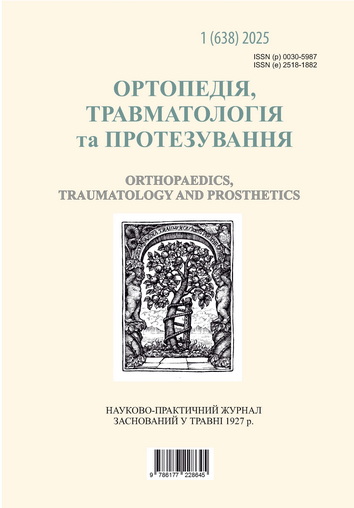ANKLE ARTHRODESIS AFTER COMBAT RELATED INJURIES
DOI:
https://doi.org/10.15674/0030-59872025113-20Keywords:
Combat related injuries, ankle joint, arthrodesis, resistance of the limbAbstract
Combat related injuries of the ankle joint (AJ) are often accompanied by severe changes in the musculoskeletal system, which require arthrodesis of the damaged joints in the final stage of treatment. Objective. To analyze the results of AJ arthrodesis in patients after combat related injuries, to highlight aspects of the use of different fixation methods. Methods. AJ arthrodesis was performed in 21 patients with the consequences of severe combat related injuries of the posterior part of the foot. An intramedullary locked rod (18 patients), screws (2 patients) and an Ilizarov-type external fixation device (EFD) were used for fixation in one patient. The results were assessed no earlier than 6 months after the start of loading using the AOFAS (posterior part), SMFA (short musculoskeletal functional assessment) and EQ-5D-5L (mobility, self-care, usual activity, pain, anxiety, VAS) scales and questionnaires. Results: In the specified terms, the results were traced in 21 patients. A differential approach was used in choosing the method of fixation of the AJ. A significant increase in function was obtained according to the AOFAS, SMFA and EQ-5D-5L scales (p ˂ 0.001). Conclusions. AJ arthrodesis in patients with the consequences of severe combat related injuries allows to restore the resistance of the limb and is the final stage of treatment of these patients.
Downloads
How to Cite
Issue
Section
License
Copyright (c) 2025 Volodymyr Piatkovskyi, Olena Turchin, Taras Omelchenko, Tetiana Yevlantieva, Vasyl’ Kharchyk, Andrii Liabakh

This work is licensed under a Creative Commons Attribution 4.0 International License.
The authors retain the right of authorship of their manuscript and pass the journal the right of the first publication of this article, which automatically become available from the date of publication under the terms of Creative Commons Attribution License, which allows others to freely distribute the published manuscript with mandatory linking to authors of the original research and the first publication of this one in this journal.
Authors have the right to enter into a separate supplemental agreement on the additional non-exclusive distribution of manuscript in the form in which it was published by the journal (i.e. to put work in electronic storage of an institution or publish as a part of the book) while maintaining the reference to the first publication of the manuscript in this journal.
The editorial policy of the journal allows authors and encourages manuscript accommodation online (i.e. in storage of an institution or on the personal websites) as before submission of the manuscript to the editorial office, and during its editorial processing because it contributes to productive scientific discussion and positively affects the efficiency and dynamics of the published manuscript citation (see The Effect of Open Access).














